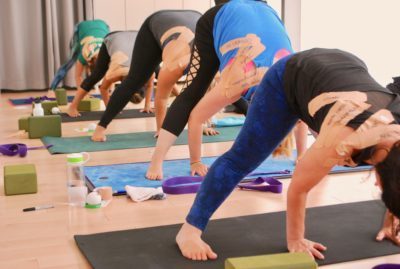
There are lots of ways to present yoga practice and as teachers, we have the ability to shift just about anything we want in the practice. We can change the sequence, change the pace, the amount of time we hold students in a pose, change up our cues and how much time we allow for silence, for instance.
One thing to consider, especially in our current culture of technology dependance, is to make changes to the traditional presentation of the practice, given our predominant posture of hunching most of the day. The other thing to consider addressing in your sequencing is the idea that most students are just overall pretty tight and their range of motion in joints like the shoulder and hip can be limited. So, keeping those things in mind, here FIVE ways to consider modifying the yoga practice:
- Starting students on the back instead of Child’s Pose: Did you ever think that this pose can be one where it’s difficult to breathe? You’re facing the floor, all curled up… how easy it is to get in oxygen? Think about starting your students on their back as way to encourage deep breathing and opening the tight internal rotators of the shoulder.
- Avoiding leg lifts before stepping into any lunge: When did this become all the rage? I remember back in the day, we simply stepped into the lunge. Think about all the “hands down” positioning we have in yoga and once you realize that, you’ll look for lots of ways to preserve the wrists. Also, avoiding the leg lift will help your students strengthen their core. Bonus!
- Cueing to “feet at hip width” rather than “feet together:” In the traditional yoga practice, we’re always asking people to bring their feet together. But now their hips are wider than their foundation which automatically means there is an element of balance. Look for ways you can use “feet at hip width” to create a steadier foundation.
- Skipping low push up several times during class: With all the “high to low push up” transitions we do in a typical class, this makes for really tight pectoral muscles and in most people they’re already overly tight there. Look for times to ask them to avoid low push up entirely.
- Cueing to “hand on the inside” in twists instead of the outside of the leg: Students often think that having their lower hand on the outside in a twist means they are “winning” in the pose because it’s harder. But in many cases, they don’t have the required flexibility to get there so the whole pose just lacks stability. Avoid this by teaching students to simply put the hand on the inside of the front leg and better yet, use a block. This will help them open up the internal rotators of the shoulders, just as we discussed in point 1.
I go through ALL of this in greater detail in my latest Facebook Live in my Anatomy workgroup on Facebook. To see the video and join the group for ongoing discussions on anatomy and yoga teaching, click here.Â
Also, to learn more about cues, check out my updated webinar on cues here.Â
Thanks for reading and leave a comment below!Â
